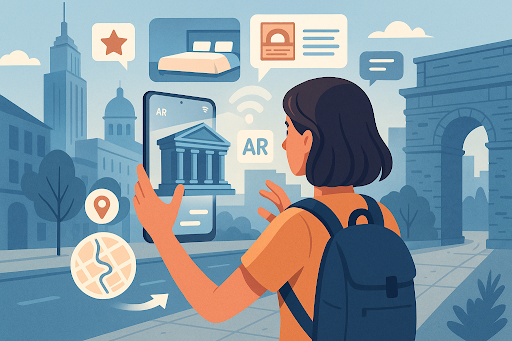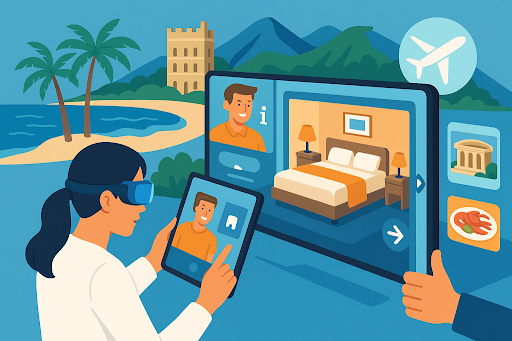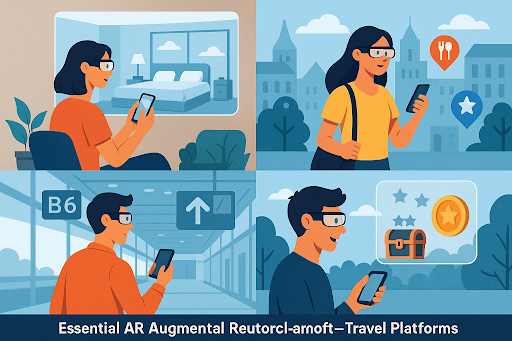
Travel
Boost Travel Bookings with AR-Powered Experiences
Introduction: The Rise of Personalization in Travel
In the age of travel books and travel agents to the digital reservations and fast access to information, travel has always been influenced by innovation. A new era of travel, however, is emerging, one characterized by immersive technology. The way people plan, navigate, and enjoy travel is being transformed by Augmented Reality (AR), a powerful tool that is now on the rise.
With AR technology, tourists are no longer confined to static brochures or basic web photographs. instead, they become active participants by using smartphones or AR glasses to overlay digital information—such as interactive storytelling, historical data, or directions—directly onto the real world. Because of the merging of the digital and physical worlds, travel is becoming much more interesting and educational.
- Real-time directions are projected into streets using AR navigation applications, which clear up misunderstanding in new places and facilitate easier exploration.
- Before visiting a place, users may "visit" landmarks, museums, or hotel rooms via virtual and interactive tours, which improves accessibility and planning.
- Traveler’s appreciation and comprehension are enhanced by contextual overlays at locations or attractions, which instantaneously present tales, reviews, menus, or translated information.
- AR is being used by hotels and airlines to simplify processes and provide individualized services.
- Travelers looking for something new are drawn to places and organizations who use augmented reality (AR) to create memorable, shareable experiences in the highly competitive tourism industry.
With predictions indicating a massive increase in the use of mobile augmented reality, this technology has the potential to transform travel from a passive itinerary into a dynamic, engaging experience.
Why the Travel Industry is Embracing AR

The travel industry is rapidly embracing augmented reality (AR) as traveler expectations evolve and competitive pressures intensify. Modern travelers, especially younger generations and digital natives, crave unique, personalized, and immersive experiences that go beyond traditional sightseeing. AR technology empowers travel brands to deliver engaging and interactive journeys from booking through exploration, transforming the way people discover and connect with destinations.
Travelers now expect:
- Personalized content, such as real-time information overlays highlighting hidden gems, local stories, and interactive recommendations tailored to their interests.
- Immersive experiences, including the ability to preview hotel rooms, virtually explore landmarks, or see animated historical reconstructions during city walks.
- Seamless information access, with AR-enabled navigation, translation, and digital guides available instantly via smartphones, improving comfort and convenience.
As competition intensifies among online travel agencies (OTAs) and direct booking channels, AR adoption provides a clear edge:
- Standout marketing and customer trust: Virtual tours and interactive previews help travelers make confident decisions, increasing bookings and reducing cancellations.
- Rich storytelling and engagement: Interactive guides, 3D models, and AR navigation make destinations come alive, deepening traveler engagement and satisfaction.
- Operational benefits: AR can drive bookings to on-site services, cut administrative costs, and offer new revenue streams through innovative experiences.
- Continuous innovation: The growth of wearable AR devices and contactless solutions helps travel brands stay relevant as consumer expectations quickly evolve.
Market metrics underscore this shift: The AR in travel and tourism market is projected to soar from $29.58 billion in 2025 to $109.13 billion by 2029, fueled by enhanced user experiences, rising demand for educational and cultural tourism, and strategic tech partnerships.
In summary, AR is no longer a futuristic novelty—it's becoming a core differentiator in the travel industry, meeting the growing demand for memorable, personalized, and technology-driven journeys.
Key reasons travel brands are embracing AR:
- Deliver immersive, memorable, and sharable experiences
- Meet rising guest expectations for personalized journeys
- Stand out in a crowded and digital-first marketplace
- Boost bookings through real-time previews and confidence-building tools
- Streamline operations and enable more efficient, digital support channels
Key Challenges in Traditional Travel Booking Experiences

Traditional travel booking experiences face significant challenges that can leave travelers feeling uncertain, uninspired, and frustrated. While the promise of choice and convenience exists, the reality often falls short, leading to hesitation and high drop-off rates.
Many travelers struggle with a lack of visualization when booking trips through traditional channels. Without clear imagery or interactive tools to imagine their destination, hotels, or activities, it becomes difficult to confidently make decisions. This uncertainty increases indecision, causing people to pause mid-booking or abandon the process altogether.
Generic, uninspired content is another key challenge. When travel options are described using standard wording and lack personal relevance or excitement, travelers may not feel emotionally connected to the journey they are planning. This absence of inspiration results in higher rates of booking abandonment, as people seek out more engaging or tailored experiences elsewhere.
From a broader perspective, these difficulties are compounded by a growing range of options and increasingly complex booking systems. With available choices multiplying, travelers can feel overwhelmed rather than empowered. For instance, the number of air travel options has grown significantly, and over half of travelers now find it harder to understand airline offers and worry about hidden fees or penalties. Furthermore, the booking journey has become more fragmented, with travelers often needing to visit multiple sites, research endlessly, and face analysis paralysis before making a decision.
Key challenges in traditional travel booking:
- Lack of visualization: Inability to see destinations or accommodations clearly leads to uncertainty and indecision during booking.
- Generic content: Basic or uninspired descriptions fail to build trust or excitement, increasing the likelihood that travelers will abandon their bookings.
- Overwhelming choices: The explosion in available travel options leaves the majority of travelers feeling uncertain about their choices and anxious about missing better deals.
- Fragmented booking process: Multiple steps and touchpoints across different platforms make the experience complex and tiring, elongating the decision-making funnel.
- Anxiety and doubt: After booking, many travelers wonder if they got the best value or made the right choices, driven by too many options and lack of clear guidance.
Addressing these challenges requires a human-centered approach that combines clear visualization, personalized and engaging content, and a streamlined booking experience that restores confidence and inspires genuine excitement about upcoming travels.
Benefits of Implementing AR in Travel Booking

Implementing augmented reality (AR) in the travel booking experience offers transformative benefits for both travelers and providers, enhancing how users discover, choose, and commit to trips.
When customers interact with AR-enabled platforms, they gain enhanced pre-booking engagement—virtual tours of hotels, rooms, and destinations let them explore spaces and attractions in detail before making a decision. This immersive preview sparks excitement, assures quality, and taps into travelers’ desire for unique, interactive experiences. Because travelers can “experience before they buy,” they gain greater booking confidence and are far more likely to finalize their reservations. It’s been shown that travel companies integrating AR see higher engagement and increased bookings, sometimes seeing jumps of up to 190% in specific campaigns. This confidence extends across every touchpoint: from viewing local attractions to previewing hotel amenities or seeing the exact view from a potential room.
Travel brands also benefit through increased upselling and cross-selling opportunities. Immersive content makes it easy to recommend excursions, upgrades, or add-ons directly in the booking process. For example, as travelers virtually tour a destination or hotel, they can be shown nearby experiences, dining options, or exclusive activities, which increases average order value and revenue. AR travel apps have enabled travelers to discover new excursions, with 79% of travelers willing to add more activities after engaging with AR-enhanced content.
Key benefits of AR for travel booking include:
- Interactive virtual tours: Showcase rooms, amenities, and destinations to allow “try before you buy” confidence.
- Increased conversion rates: Engaged, informed customers are more likely to book and less likely to cancel.
- Personalization: AR can deliver tailored recommendations, creating a unique trip planning experience for each user.
- Enhanced marketing: Eye-catching AR content holds users’ attention and builds brand trust.
- New revenue streams: Upsell premium experiences and cross-sell nearby activities directly within the booking flow.
Incorporating AR humanizes the travel booking process—inviting travelers to dream, explore, and commit, all with a sense of certainty and excitement about their adventure ahead.
Essential AR Features for Modern Travel Platforms

Modern travel platforms are being transformed by essential augmented reality (AR) features that deliver genuinely immersive, interactive, and delightful experiences for travelers. As technology and expectations evolve, these humanized AR tools are quickly becoming must-haves for platforms aiming to stay relevant and competitive.
Virtual Hotel and Attraction Walkthroughs
- Enable travelers to take realistic, 360-degree tours of hotels, attractions, and even city streets before booking. This helps users make informed decisions and visualize their stays or visits from anywhere in the world.
- Enhance pre-trip planning and reduce post-booking regrets, allowing guests to explore amenities and room types virtually.
Interactive City Guides and Point-of-Interest Overlays
- AR city guides transform sightseeing by overlaying real-time information about landmarks, restaurants, shops, and hidden gems directly onto the user’s camera view.
- These interactive guides deliver audio, visual, and text content on-the-fly, creating a richer, more navigable travel experience.
Step-by-Step AR Navigation in Airports or Large Venues
- Navigating busy airports, complex hotels, or expansive museums becomes frictionless with step-by-step AR navigation, which displays arrows or instructions over real-world images to guide users effortlessly to gates, lounges, or points of interest.
- Features include real-time location tracking, emergency information overlays, and clear visual cues for stress-free wayfinding.
3D Visualization of Rooms, Amenities, or Seating Choices
- Travelers can explore rooms, facility layouts, or even airline seating options with 3D AR models, helping them select what suits their comfort and needs best, well before arrival.
- This adds transparency and empowers individualized choices.
Gamified Travel Discovery for Engagement and Loyalty
- Gamified AR experiences—like scavenger hunts, virtual treasure hunts, or interactive quizzes—turn exploration into fun, boosting traveler engagement and fostering loyalty.
- Such features encourage more exploration and social sharing, building lasting platform-user relationships.
For a deeper conversation or to see these features in action, you can book a meeting here: Meeting Link
Tech Stack and Investment Overview for AR Integration
Integrating Augmented Reality (AR) into your business or product requires a thoughtfully selected tech stack and a clear understanding of the investment landscape. To enable seamless and interactive AR experiences, you need a blend of AR SDKs, robust mobile app frameworks, and advanced 3D modeling resources.
Key Technologies for AR Integration
- AR SDKs: Leading options include ARKit (iOS), ARCore (Android), Vuforia, and ARToolKit. These provide the core functionalities—object recognition, tracking, and scene understanding—required for AR.
- 3D Modeling: Essential for the creation or adaptation of digital content overlaid in the real world. Tools such as Blender, Maya, and Unity’s modeling capabilities are frequently used to craft and animate 3D assets.
- Mobile App Integration: Platforms like Unity and Unreal Engine offer cross-platform deployment, while native mobile frameworks (Swift/Objective-C for iOS, Java/Kotlin for Android) ensure smooth integration with device hardware and sensors.
Investment Considerations
When planning your AR initiative, consider the following:
- Platform Compatibility: Ensure your technology works across a wide range of devices, from high-end smartphones to more basic models. Achieving cross-platform reliability often increases development complexity and costs, but expands your user reach.
- Scalability: Choose frameworks and infrastructure (such as cloud storage or real-time databases) that support growth and high user activity, without sacrificing performance.
- Maintenance: Factor in ongoing updates for SDKs, OS upgrades, and compatibility with new hardware. Continuous support is crucial to maintain security and user experience as platforms evolve.
When you’re ready to take your AR project to the next level, whether it’s for engaging booking platforms or immersive travel content, partnering with an expert team can help turn your vision into reality. For personalized consultation and a tech roadmap tailored to your needs, reach out at Contact us.
How Travel Businesses Can Implement AR-Powered Solutions
Travel businesses can implement AR-powered solutions to create engaging, interactive experiences for travelers, driving differentiation in a competitive tourism landscape. There are two primary approaches:
- Partner with AR platform providers: Many established AR technology companies offer ready-made platforms that travel businesses can integrate with their apps or services. This route allows for faster deployment and reduces technical risks while leveraging existing expertise.
- Invest in custom AR development: For more tailored experiences, businesses may opt for custom AR solutions, designed to meet specific branding, regional, or operational needs. This requires a carefully selected development partner and often a larger upfront investment, but provides greater control and uniqueness.
When it comes to content creation strategies, travel businesses should blend professional assets with user-generated content for vibrant and authentic AR experiences:
- Use professional assets: High-quality 3D models, carefully curated location information, and professionally narrated audio tours enhance the credibility and richness of AR overlays at key destinations.
- Encourage and incorporate user-generated content: Invite travelers to share reviews, photos, videos, or even short stories via the AR platform. This user input not only boosts engagement but also helps keep information relevant and diverse.
- Mix both content types to provide a continuous stream of updated, varied information that appeals to a wide array of travelers.
Best practices for AR implementation in travel:
- Start with high-impact locations: Prioritize AR rollouts in top tourist attractions, historically significant sites, or high-traffic transportation hubs to maximize initial impact and gather meaningful data quickly.
- Continuously test and adapt: Collect user feedback through in-app surveys, behavior tracking, and social channels. Use these insights to refine experiences, optimize technical performance, and add features visitors truly value.
- Prioritize user experience: Ensure ease of use, quick app performance, and multilingual support to accommodate global travelers.
- Promote accessibility: Develop AR features that work on mainstream smartphones, and offer options for travelers with different abilities, making experiences inclusive.
By focusing on these approaches, travel businesses can humanize each journey, fostering memorable and personalized travel for adventurers worldwide.
Case Studies & Success Stories: Travel Brands Winning with AR
Travel brands are redefining the booking journey and in-destination experience by embedding augmented reality (AR) into their platforms and services. Both online travel agencies (OTAs) and hotels are leveraging AR to address core traveler needs, from building early trust to removing friction during booking, and ultimately boosting satisfaction throughout the stay.
Case Studies: OTAs & Hotels Driving Results with AR
Several innovations illustrate how AR is reshaping travel—enhancing both customer engagement and business performance:
- OTAs deliver immersive destination previews: By letting travelers use smartphones to virtually explore hotel rooms or stroll through destinations, OTAs build confidence in what’s being booked. This “try-before-you-buy” approach directly reduces uncertainty and booking hesitation, resulting in higher conversion rates and longer engagement times on their platforms.
- Hotels offer interactive 3D room tours: Many chains now provide detailed AR walkthroughs of rooms and facilities, accessed through their apps or booking sites. This transparency and interactivity remove barriers to purchase—travelers are better informed, leading to increased bookings and reduced abandonment during checkout.
- Navigation & local discovery tools: AR-powered navigation helps travelers find their way around hotels, resorts, or unfamiliar cities. By pointing their device, guests access real-time directions to amenities, local sights, or transport links. This not only minimizes confusion but keeps users engaged with the platform, unlocking cross-sell and upsell opportunities for the business.
Key Outcomes Noted by Leading Brands
- Increased time on platform: Engaging, interactive AR features retain travelers longer, exploring more services and options before booking.
- Higher conversion rates: Virtual previews and guided tours build trust, resulting in a significant uplift in bookings for both hotel direct channels and OTAs.
- Reduced booking friction: Clear, visual information answers travelers’ questions in advance—simplifying choices and lowering cart abandonment.
- Elevated satisfaction: Guests report greater satisfaction at every stage, from research to stay, due to personalized and immersive experiences.
Travel brands embracing AR are not only creating memorable experiences, but also achieving measurable gains on the metrics that matter for growth and loyalty.
The Future of AR in Travel: Beyond the Booking
Augmented Reality (AR) is fundamentally transforming the way travelers plan, experience, and share their journeys. As we move beyond traditional booking platforms, the integration of AR with artificial intelligence (AI) and automation is setting the stage for a new era of seamless, immersive, and highly personalized travel.
AR-Powered Itinerary Planning
Travelers will soon expect AR-driven previews and interactive trip planning tools. By overlaying real-world visuals and digital content, users can virtually tour accommodations, check the actual view from a balcony, and explore neighborhoods before making any commitment. This approach reduces uncertainty and boosts traveler confidence, making the planning stage much more engaging and interactive. With AI-driven personalization, these AR tools will adapt to individual preferences, interests, and real-time moods, leading to unique itineraries curated just for each user.
Real-Time Trip Enhancements
Once on the ground, AR will elevate every aspect of the journey:
- Turn-by-turn navigation layered directly over city streets or hiking trails.
- Historical overlays at landmarks, bringing ancient ruins or moments from the past to life.
- Instant translations of signs, menus, and conversations for smoother cross-cultural experiences.
Emerging wearable devices, such as AR-powered smart glasses, will allow travelers to leave their phones pocketed and stay fully engaged in the environment while still receiving contextual information or guided assistance.
Social Sharing and Viral Marketing
AR will make travel far more shareable and social:
- Unique, interactive content—like custom filters or immersive “travel stories”—will help users create experiences that are ready to go viral.
- In-destination AR challenges and digital souvenirs can trigger social buzz and prompt others to explore similar adventures.
User-generated AR content will drive “FOMO,” inspire others, and offer powerful, organic marketing opportunities for destinations and brands.
AI and Automation Advancing Travel
AR’s evolution is closely linked to advances in AI and automation:
- AI-powered “agents” will offer real-time recommendations, handle bookings, and respond proactively to traveler needs throughout the trip—far beyond what standard travel apps currently provide.
- Autonomous systems will blend digital identity with trip preferences, shopping, and even personalized support, reshaping every step of the travel experience.
By blending physical and digital worlds, the next generation of travel promises not just convenience, but truly memorable, tailor-made adventures.
Conclusion
Augmented Reality (AR) is providing the travel industry with an exceptional competitive edge, making travel brands more relevant, innovative, and customer-centric. AR transforms the way travelers interact with destinations by overlaying digital information onto the physical world, turning each journey into a personalized, immersive experience.
With AR, travel companies can:
- Offer simplified navigation and self-guided tours, ensuring travelers explore destinations confidently without relying on traditional guides, no matter the language or location.
- Deliver on-demand destination information instantly through smartphones, such as details about landmarks, eateries, or local customs, making every trip informative and hassle-free.
- Enable virtual tours of hotels, attractions, and experiences, allowing guests to preview offerings before booking, building confidence and trust in your brand.
- Enhance marketing efforts with visually rich, interactive content that differentiates your brand and drives engagement in an oversaturated travel marketplace.
- Open up new revenue streams and increase bookings by showcasing amenities, upgrades, and local services in a captivating way, often leading to spontaneous decisions and last-minute conversions.
The Competitive Edge of AR in Travel:
- Immersive engagement: Make static travel offerings come alive with interactive storytelling and real-time guidance.
- Hyper-personalization: Empower guests with tailored recommendations and localized content, surpassing expectations and strengthening loyalty.
- Operational efficiency: Streamline guest assistance, reduce manual interventions, and optimize staff resources with automated AR solutions.
- Market growth: The AR travel market is projected to grow rapidly—adopting AR now ensures you don’t get left behind.
Now is the moment to act. By implementing AR, travel businesses can deliver next-generation experiences that today’s travelers expect, delighting customers and increasing bookings in an increasingly competitive industry. Don’t miss the opportunity to shape the future of travel—embrace AR technology and start exceeding guest expectations while boosting your bottom line.
If you’re ready to see how AR can transform your travel business, let’s connect for a personalized strategy session: Book a meeting.

Your Tech Partner for Scalable Travel Growth
We’re here to help you shape your business, so reach out to us today.
